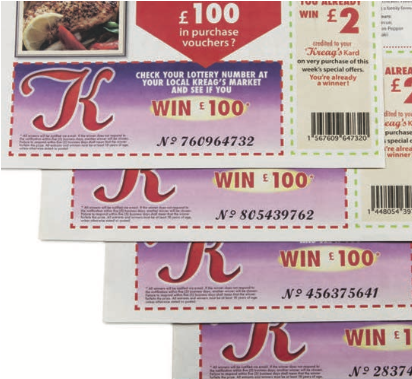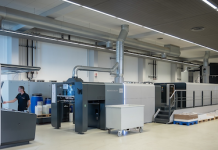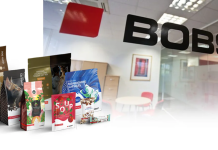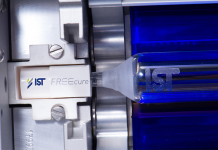It’s been nearly 10 years since drupa 2008, the show that was unofficially called 'The Inkjet drupa'. It was the time when high-speed digital production inkjet had begun to hit critical mass, and industry pundits were pointing out that inkjet was slated to become the 'next big thing' in commercial printing. The thing is, they were right. This article was published in the Africa Print Journal.
Production inkjet has taken the industry by storm, almost as much as the original advent of digital printing in the 1990s. In the decade or so since production inkjet burst onto the scene, it has become common to hear the technology spoken of in the context of '…taking work away from offset,' or at the very least, '…taking work away from toner-based digital presses.'
Even at the SGIA Expo, it is not unusual to hear certain types of wide format printers, such as UV flatbed presses, promoted as '…taking work away from offset' — namely posters and point-of-purchase graphics. One gets the sense that offset has a big target on its back.
While we still often hear inkjet talked about in that way, as the technology has evolved and its capabilities have expanded, the value proposition of inkjet today is less about shifting work from one technology to another and more about using it to create new, unique print applications — complementing rather than replacing analogue technologies like offset.
The truth is, there are many factors driving the growing adoption of production inkjet over the past decade — and the extent that 'taking work away from offset' is only a small part of the story.
Jetways
First, though, let’s make sure we’re all on the same digital page. What do we mean by 'production inkjet'? Surely, anything produced on an inkjet device — including wide-format output — could technically be considered 'production inkjet'. However, in commercial printing, what is typically meant by the term is inkjet printing on paper at high speeds, often measured in hundreds of — even a thousand or more — metres per minute. Production inkjet machines can be colour or black-and-white, and although the former has been where most of the action is, there is still a very strong market for monochrome equipment.
The majority of the units on the market are continuous-feed (i.e. webfed) although Canon Solutions America (CSA) launched the Océ VarioPrint i300 cut-sheet device and Fujifilm has long had its J Press 720S sheetfed inkjet press. When they first appeared on the market, production inkjet presses were touted for a few primary commercial printing applications: transactional (e.g. statements, invoices, etc.), book printing and certain kinds of direct mail.
However, while those three still remain big markets for inkjet, advances in media handling, speed, ink, paper and virtually every other aspect of the equipment and the workflow have allowed inkjet to move into other niches — and even spawn the invention of entirely new types of printing applications. And not surprisingly, there is an increasing number of players in the production inkjet market.
Water, Water, Everywhere
According to research from Smithers Pira, digital printing (toner and inkjet) accounts for 2.9 percent of print volume in 2017, up from 2.1 percent five years ago, and is expected to hit 3.9 percent by 2022.
As for digital inkjet, I.T. Strategies has forecast that by 2019, 58 percent of digital colour volume will be printed via inkjet. At the risk of mixing and matching different forecasts (mixing apples and oranges to create a lovely fruit salad), that would mean that more than half of the roughly three percent of digital page volume will be inkjet. Now, that may not sound like a lot, and given the explosive growth of digital, offset lithography is still expected to account for 70 percent of overall volume for the foreseeable future.
However, when we look at overall volume numbers, remember that digital jobs tend to be short-run and low-volume compared to offset — say, 500 to 1000 impressions for digital vs.10,000-plus for offset (or flexo, if we’re talking about packaging). So while overall volume will still be dominated by analogue technologies, on a per-job basis — as the number of jobs increases — digital, and digital inkjet in particular, accounts for a growing percentage of those new jobs and the pages produced for them. Think about it this way: of all the water on Earth, less than three percent of it is freshwater, but it’s a pretty important three percent!
Keeping It Short
Ask anyone in the industry, and they will tell you anecdotally that run lengths are declining. However, getting concrete data on trends in run lengths is fraught with difficulty (some years ago, I was part of a research team that attempted to glean such data) and it’s hard to get reliable numbers that quantify the common phrase 'run lengths are declining'. By one estimate (Neil Falconer, Print Future 2015, drupa Insights), high-volume run lengths are declining by 45 percent.
Here’s the caveat, though: ask 10 different printers what they mean by 'short- run' or 'high-volume' printing, and you’ll get 10 different answers. For some, short-run could be under 1000 impressions; for others, it could be under 100 — or even a single impression. For a publication printer accustomed to printing millions of copies of items like magazines or catalogues, 'short-run' could be anything under one million impressions!
Another nuance to looking at run lengths is personalisation. Take variable data printing (VDP), where you can vary the content of a page either slightly (adding a name like a simple mail-merge) or completely (swapping out 100 percent of the text and graphics on a per-piece basis). If a printer is running 5000 sheets and each one is slightly different — say, it’s personalised to a given recipient — is that one 5000-copy run, or 5000 one-copy runs? These are the things that keep industry statisticians and market researchers up at night.
This seems like a bit of a tangent, but suffice to say, any discussion of run length requires a series of qualifiers.
You may ask, with all the toner-based digital presses already on the market, what is the value proposition of production inkjet? First of all, speed. Inkjet is faster than toner, which improves shop throughput. Production inkjet is also capable of efficiently handling longer runs — maybe not as long as the longest offset or gravure runs, but longer than what toner-based equipment can productively handle. So you often find vendors and users of inkjet equipment talking about the 'sweet spot,' or where production inkjet bridges the gap between offset and toner-based digital.
And, again, we need to qualify what we mean by 'long-' and 'short-' run, particularly when it comes to variable jobs. A printer may need to do a run of 100,000 impressions, each one of them different (but, again, is that 100,000 single-impression runs?). That’s impractical on an offset press, and cost- and time-prohibitive on toner-based digital. This is where production inkjet becomes an appealing option.
WICO Suave
Production inkjet also helps reduce costs in other ways, and the growth of inkjet has also spawned a new acronym and 'buzzword,' commonly used when talking about transactional printing: WICO, which stands for 'white in, colour out'. It essentially refers to the efficiencies to be had by eliminating what are called 'offset shells'. Say you’re printing credit card statements.
They have two basic components: the static text and graphics (such as the credit card company logo and other boilerplate content) and the personalised data (the account holder’s actual purchases and other information). Traditionally, the static content would be mass-produced on an offset press and warehoused. When it was time to do a run of statements, these 'shells' would be re-run through a digital press to add the personalised information.
You can see the drawbacks to this workflow. It requires two separate stages of production, it incurs the cost of warehousing, and it can result in a great deal of waste if the credit card company changes its logo, the terms of service, or any other information printed on the shells, which then have to be destroyed and reprinted. With a 'white paper in' approach via production inkjet, all the static and personalised content is printed at once, in one pass. No shells, no warehousing and no needing to ensure that the shells have the most up-to-date content.
Tiering Up
The 'killer app' for digital printing in general has always been its ability to do VDP, although there are different levels or 'tiers' of VDP involved.
The poster child for VDP is the 100-percent variable page: database-driven rules can vary the text and graphics based on the recipient. If a marketer — say, an insurance company — knows that Richard Romano is an avid runner, then that marketer can produce customised mailings, such as insurance plan welcome or renewal packets that include pictures of races and runners and other relevant images. If that same marketer knows that another mailing recipient is a chess player, then that same packet would instead have pictures of chessboards and pieces, and other imagery relevant to that recipient, and so on.
This 'full throttle' VDP is highly effective, but has its challenges, such as poor databases on which to draw. It also takes a lot of software and hardware horsepower to process all that data, especially if you’re talking long runs of these kinds of materials. On the hardware side at least, production inkjet is proving itself up to the task. A more common and less intensive kind of VDP is known as customisation or versioning. Instead of every single impression or publication varying based on recipient, 'versions' are produced that vary by broad demographic categories, such as geography. It’s worth looking at the idea of versioning in the context of inkjet newspaper production.
The Digital 'Universe'
In the great 1990s sci-fi TV series Babylon 5, the titular space station featured a kiosk that dispensed editions of the daily newspaper Universe Today. Users specified the sections and topics they were interested in, and the kiosk generated a custom printed newspaper. It’s surprising that no one has seized on this idea just yet, at least in print (it’s kind of like hard copy Google Alerts) but it is the kind of thing that production inkjet can make possible — and in fact some newspaper publishers are starting to take advantage of versioned newspapers, although it’s more common in Europe and Asia than in the US — for now.
Some newspaper publishers that serve areas frequented by holiday travellers and expatriates produce versioned production runs of daily papers in different languages. If a paper is produced in, say, France, then the French language version is transmitted to a resort or holiday community, such as the island of Reunion off the coast of Africa, where a small number of papers are printed via inkjet for the Francophone holiday-goers. Other newspaper publishers print certain portions or signatures of a newspaper digitally, then insert them into the rest of the paper which has been printed via offset.
Again, the digitally produced sections are targeted to certain small towns or villages, and can thus feature hyperlocal advertising and other content. Advertisers can also use digital inkjet newspapers for interactive advertising: each copy of an ad includes a different code that varies from copy to copy.
The ad can be a coupon that the recipient can clip, bring to a retail location, and receive a discount or a prize, or it can feature a unique QR code or personalised URL that the recipient can access online to receive individually targeted deals, discounts and other perks.
Integrating Variables
One of the more interesting aspects of personalised, customised publishing is happening in the book world. Book printing was identified early on as a top application for digital inkjet production, and in fact digital printing has always been a viable and cost-effective option for book printing. The rise in self- publishing via sites like Amazon’s CreateSpace and on-demand book publishing/ printing have driven investment in toner-based digital book printing capabilities, but inkjet is poised to take over — especially where book volumes fall into that no man’s land between toner-based digital and offset.
An interesting, emerging book printing application is the integration with variable elements, and even 'interactive' elements like QR codes and AR (Augmented Reality). HP’s Link technology, for example, is one application that helps make books and other printed materials become interactive. It can even add personalised messages to books. For example, an edition of the book Unsquaring the Wheel by Christopher Bondy, Wayne Peterson and Dr. Joseph Webb was published by HP and included the Link technology. A select 100 or so received copies of the book that featured the ability to scan the cover and receive a personalised video message. This requires not only the ability to add QR/AR links to printed materials, but also vary the codes from book to book — something that production inkjet can help make possible.
The New Jobs
The uses for production inkjet are proving to be myriad. Some printers are investing in the technology to efficiently handle shorter runs and thus complement their offset capabilities, while others are seeking to use the technology to develop entirely new kinds of print applications and marketing solutions for their customers. The principles of production inkjet are expanding beyond commercial printing into packaging and label printing, for many of the same reasons. At the end of the day, production inkjet — or any digital printing, really — is not about taking jobs that were meant for offset or other analogue technologies. Rather, it’s about creating new kinds of jobs that were never offset’s to begin with.
Richard Romano has been writing about the graphic communications industry for more than 20 years, and has covered wide format printing since 1998. He is a senior analyst for news and information portal WhatTheyThink.com, where he is the section editor for the Wide Format page. He also contributes to Wide Format & Signage and Printing News magazines. His most recent book is a collection of historical essays called Printing Links: History, Science, Technology and the Graphic Arts, defiantly available in print only at Amazon.com.
This article first appeared in the SGIA Journal and is reprinted with permissions from the Specialty Graphic Imaging Association. www.SGIA.org.





















